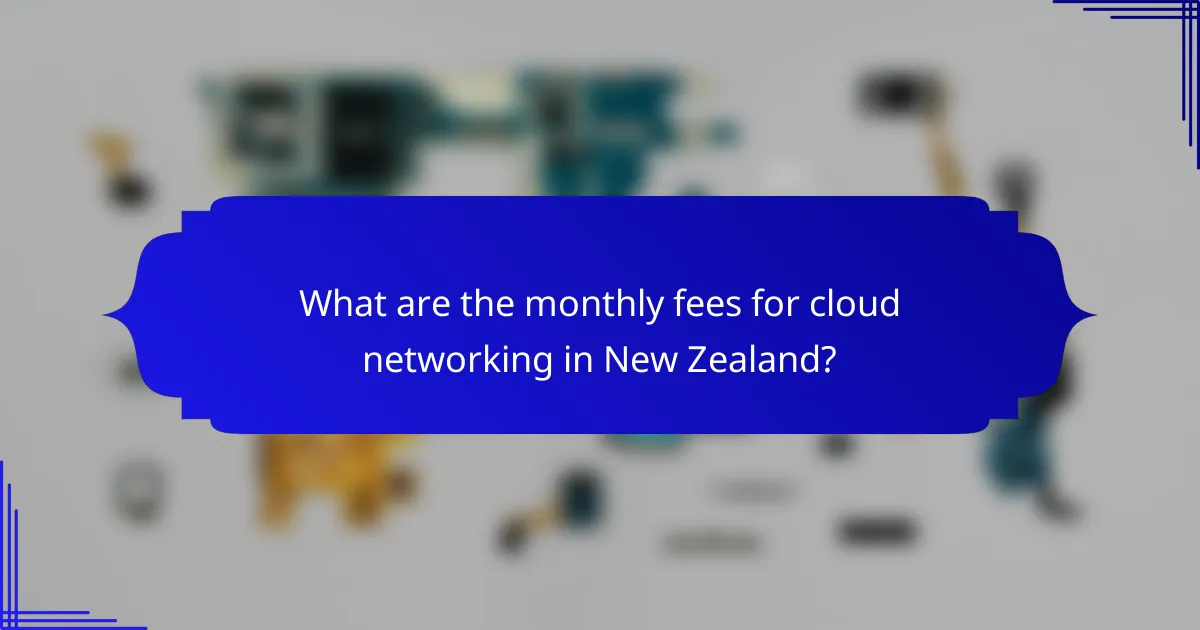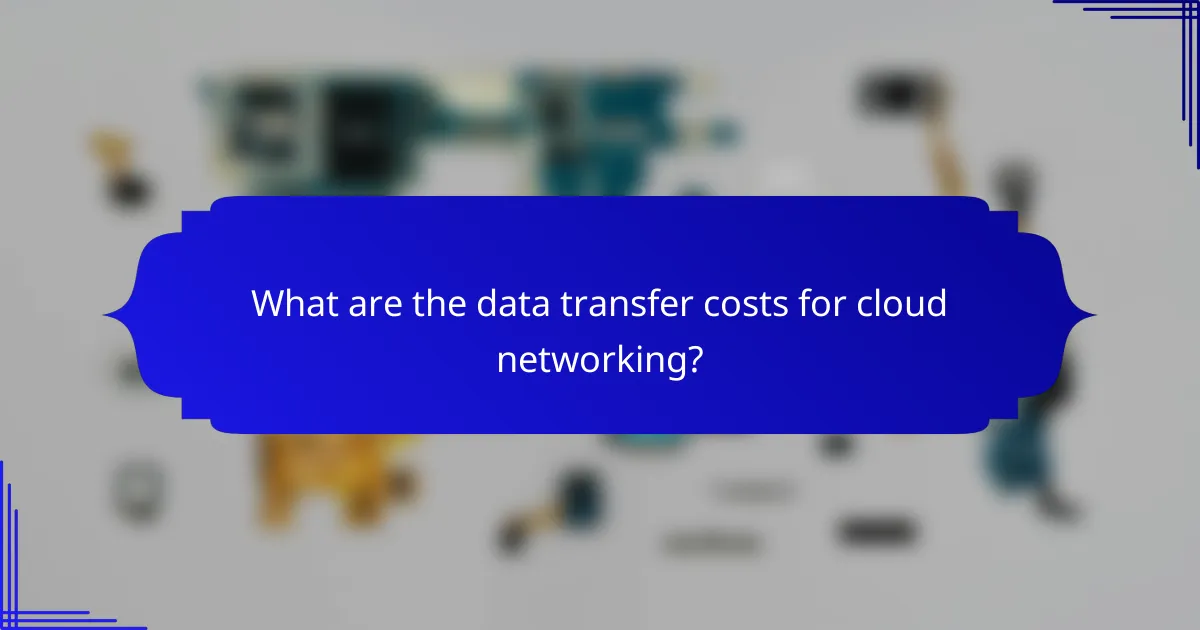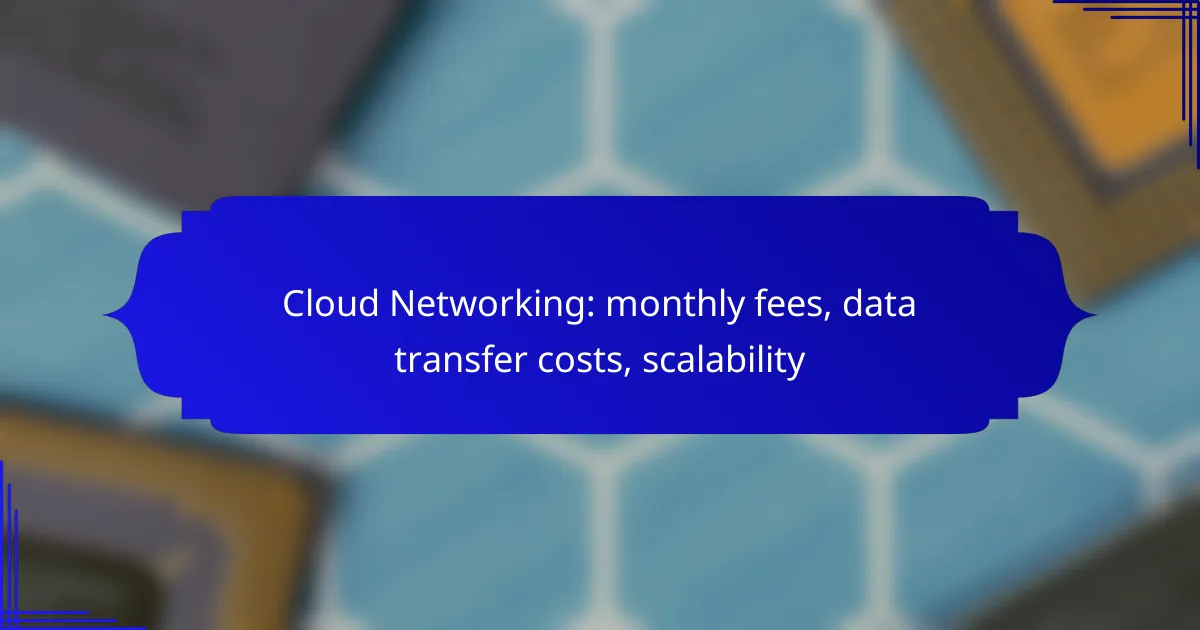Cloud networking offers businesses a flexible and scalable solution for their connectivity needs, with monthly fees ranging from NZD 50 to several thousand NZD depending on usage. Data transfer costs can vary widely, typically charging for outbound data while often providing free inbound transfers. This adaptability allows organizations to efficiently manage resources in response to changing demands, minimizing upfront investments.

What are the monthly fees for cloud networking in New Zealand?
The monthly fees for cloud networking in New Zealand can vary significantly based on the provider and the services utilized. Generally, businesses should expect to pay anywhere from NZD 50 to several thousand NZD per month, depending on their specific needs and usage patterns.
Average monthly fees for AWS
Amazon Web Services (AWS) offers a pay-as-you-go pricing model, which can lead to monthly fees ranging from NZD 100 to NZD 1,500 for small to medium-sized businesses. Costs depend on factors like data transfer, storage, and the specific services used, such as EC2 or S3.
For example, a basic EC2 instance can start at around NZD 50 per month, while additional services like RDS or Lambda can increase the total significantly. It’s crucial to monitor usage closely to avoid unexpected charges.
Average monthly fees for Microsoft Azure
Microsoft Azure’s pricing is also usage-based, with monthly fees typically falling between NZD 80 and NZD 2,000 for various services. Factors influencing costs include the number of virtual machines, storage options, and data transfer rates.
A small virtual machine may cost around NZD 60 monthly, while more complex setups with multiple services can lead to higher fees. Azure provides a pricing calculator to help estimate costs based on anticipated usage.
Average monthly fees for Google Cloud
Google Cloud Platform (GCP) features a flexible pricing structure, with monthly fees generally ranging from NZD 70 to NZD 2,500. The costs are influenced by the services chosen, such as Compute Engine or Cloud Storage, as well as the volume of data processed.
A basic Compute Engine instance might start at approximately NZD 50 per month, but additional features and services can quickly escalate costs. GCP also offers a pricing calculator for better budget management.

What are the data transfer costs for cloud networking?
Data transfer costs for cloud networking vary significantly between providers and depend on factors like the volume of data and the direction of transfer. Generally, charges apply for data leaving the cloud to the internet, while inbound data transfer is often free.
Data transfer costs for AWS in New Zealand
In New Zealand, AWS charges for data transfer out to the internet based on usage tiers. The first gigabyte is usually free, while subsequent data transfer can cost around NZD 0.15 to NZD 0.20 per GB for the first 10 TB. Rates decrease as usage increases, making it essential to estimate your data needs accurately.
Consider using AWS’s cost calculator to project your expenses based on anticipated data transfer volumes. Be mindful of additional charges for data transfer between AWS regions, which can also impact overall costs.
Data transfer costs for Microsoft Azure in New Zealand
Microsoft Azure’s data transfer pricing in New Zealand follows a similar tiered structure. The first 5 GB of outbound data transfer is free, with costs typically starting around NZD 0.12 per GB for the next 10 TB. Azure also offers discounts for higher usage, so planning your data flow can lead to savings.
Utilizing Azure’s pricing calculator can help you estimate your monthly fees based on expected data transfer. Keep in mind that transferring data between Azure services within the same region is often free, which can help optimize your costs.
Data transfer costs for Google Cloud in New Zealand
Google Cloud’s data transfer costs in New Zealand are structured with the first 1 GB free, followed by charges that can range from NZD 0.12 to NZD 0.18 per GB for outbound data, depending on the total volume. Like other providers, Google Cloud reduces rates as data transfer increases, so it’s beneficial to analyze your usage patterns.
To manage costs effectively, consider using Google Cloud’s pricing calculator for accurate estimates. Additionally, be aware that internal data transfers within Google Cloud services are typically free, which can help minimize overall expenses.

How scalable is cloud networking?
Cloud networking is highly scalable, allowing businesses to adjust their resources based on demand. This flexibility means organizations can easily increase or decrease their computing power, storage, and bandwidth as needed, often without significant upfront costs.
Scalability features of AWS
AWS offers several scalability features, including Elastic Load Balancing and Auto Scaling. These tools automatically distribute incoming application traffic across multiple targets and adjust the number of active servers based on current demand, ensuring optimal performance.
Additionally, AWS provides services like Amazon EC2, which allows users to quickly launch virtual servers and scale them up or down in minutes. This pay-as-you-go model helps manage costs effectively, as users only pay for the resources they consume.
Scalability features of Microsoft Azure
Microsoft Azure supports scalability through its Virtual Machine Scale Sets, which enable users to deploy and manage a set of identical VMs. This feature automatically adjusts the number of VMs based on traffic, ensuring applications remain responsive during peak times.
Azure also includes Azure Functions, which allows for serverless computing, automatically scaling resources based on the number of incoming requests. This can significantly reduce costs, as users are charged only for the compute time they actually use.
Scalability features of Google Cloud
Google Cloud provides scalability through its Compute Engine, which allows users to create and manage virtual machines with ease. It features autoscaling capabilities that adjust the number of instances based on load, ensuring applications can handle varying traffic levels without manual intervention.
Moreover, Google Cloud’s Kubernetes Engine facilitates container orchestration, making it easier to scale applications seamlessly. Users can deploy containers that automatically scale based on demand, optimizing resource usage and minimizing costs.

What factors affect cloud networking costs?
Cloud networking costs are influenced by several factors, including usage patterns, data transfer volumes, and geographic locations. Understanding these elements helps businesses optimize their expenses and make informed decisions about their cloud services.
Usage patterns and their impact on pricing
Usage patterns significantly affect cloud networking costs, as providers typically charge based on consumption. Regularly monitoring data usage can help identify peak times and adjust resources accordingly to avoid unnecessary charges.
For instance, a business that experiences fluctuating traffic may benefit from a pay-as-you-go model, while a company with consistent usage might find flat-rate pricing more economical. It’s essential to analyze historical data to predict future needs and select the most cost-effective pricing structure.
Geographic considerations for pricing
Geographic location plays a crucial role in determining cloud networking costs, as prices can vary significantly between regions. Factors such as local infrastructure, regulatory requirements, and market competition influence these variations.
For example, data transfer costs may be lower in regions with advanced connectivity and multiple service providers. Businesses should evaluate the pricing models of different cloud providers in their target regions to ensure they are getting the best deal for their specific needs.

How to choose a cloud networking provider?
Choosing a cloud networking provider involves evaluating their pricing structure, data transfer costs, and scalability options. Focus on understanding the monthly fees, potential hidden charges, and how well the provider can grow with your needs.
Criteria for selecting a provider
When selecting a cloud networking provider, consider factors such as reliability, performance, and customer support. Look for providers with transparent pricing models that clearly outline monthly fees and data transfer costs. Scalability is crucial; ensure the provider can accommodate your growth without significant price hikes.
Evaluate the provider’s compliance with local regulations, especially if you handle sensitive data. Check for security certifications and service level agreements (SLAs) that guarantee uptime and support response times.
Comparison of top providers in New Zealand
In New Zealand, popular cloud networking providers include Amazon Web Services (AWS), Microsoft Azure, and Google Cloud Platform. Each offers different pricing structures, typically charging based on usage, including data transfer and storage fees.
AWS tends to have a pay-as-you-go model, which can be cost-effective for variable workloads. Microsoft Azure offers competitive pricing with discounts for long-term commitments, while Google Cloud is known for its user-friendly interface and strong data analytics capabilities. It’s advisable to compare their pricing calculators to estimate costs based on your expected usage.

What are the emerging trends in cloud networking?
Emerging trends in cloud networking focus on enhanced scalability, cost efficiency, and improved data transfer capabilities. Organizations are increasingly adopting multi-cloud strategies and edge computing to optimize performance and reduce latency.
Monthly fees for cloud networking services
Monthly fees for cloud networking services can vary significantly based on the provider, features, and usage levels. Typically, businesses can expect to pay anywhere from a few dozen to several hundred dollars per month, depending on their specific needs and the scale of their operations.
When evaluating monthly fees, consider factors such as bandwidth requirements, the number of users, and additional services like security and support. Some providers offer tiered pricing models, allowing businesses to select a plan that aligns with their budget and usage patterns.
Data transfer costs in cloud networking
Data transfer costs in cloud networking are a critical consideration, as they can impact overall expenses. Most cloud providers charge based on the volume of data transferred in and out of their networks, with costs typically ranging from a few cents to several dollars per gigabyte.
To manage data transfer costs effectively, businesses should monitor their usage patterns and optimize data flow. Techniques such as data compression, caching, and choosing the right regions for data storage can help minimize these expenses.
Scalability in cloud networking
Scalability in cloud networking refers to the ability to adjust resources based on demand. Cloud services are designed to scale up or down quickly, allowing organizations to accommodate fluctuating workloads without significant delays or investments.
When considering scalability, businesses should assess their growth projections and select providers that offer flexible resource allocation. Utilizing auto-scaling features can ensure that resources are automatically adjusted based on real-time demand, helping to maintain performance while controlling costs.
